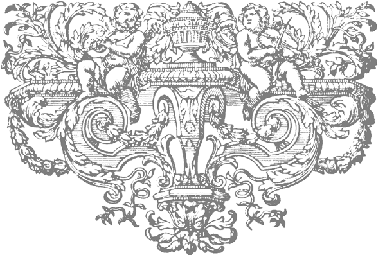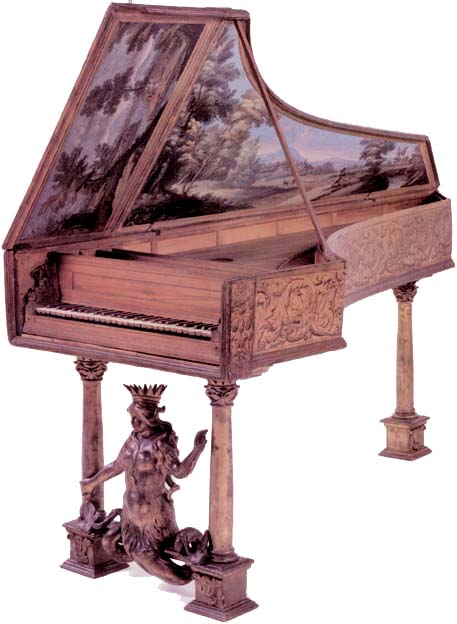Why choose a
Neapolitan harpsichord as a model for building a modern harpsichord?
Neapolitan Harpsichord, Anonymous, c.1670
Metropolitan Museum of Art, New York, NY, Museum Inv. No. 45.41
Click here for information about other instruments in the Metropolitan Museum of Arts, New York
I've often been asked why I chose a Neapolitan harpsichord as a model on which to base these modern harpsichords. Why, for example, not choose a Venetian, Florentine or Roman maker and his instruments as a basis on which to build new instruments? Indeed Venetian harpsichords seem to have acquired a certain fame and popularity among makers and players, perhaps because of the important position that Venice played in the cultural and political life of Italy during the historical period. So why not choose a Venetian instrument as model, or if not a Venetian instrument then one might have chosen an instrument by Bartolomeo Cristofori, one of the greatest harpsichord builders who has ever lived. For example, in addition to a number of new instrument types such as the spinettone and the 'spinetta ovale' - a type of oval virginal (see Il percorso di un’idea: dal progetto allo strumento/The development of an idea: from the design to the instrument) - also invented the escapement mechanism which is the basis of the modern piano action. Cristofori might therefore have been chosen as a good maker on which to base one's instruments.
But it is here that the clue to my decision to use Neapolitan harpsichords as models for the instruments described here lies. In an unpublished paper titled 'Bartolomeo Cristofori/Giovanni Ferrini as restorers and re-builders. A ‘Neapolitan’ connection in two Italian harpsichords in Britain' that I gave at the “Terzo Laboratorio Fiorentino del Fortepiano” at the Accademia Bartolomeo Cristofori in Florence on 6-7 December, 1997, I pointed out that Cristofori himself must have been in the habit of importing instruments to Florence from Naples. I found that a number of the instruments re-worked by Cristofori and Ferrini are Neapolitan in origin. Why, I thought, would Cristofori go to all the trouble of bringing old, out-of-date harpsichords all the way from Naples to Florence to re-work them when instruments by local makers must have been much more readily accessible and probably much cheaper to buy? Venetian harpsichords would probably also have been more readily available in Florence than Neapolitan instruments. But Cristofori chose to spend his time re-building Neapolitan harpsichords and not Venetian or Roman harpsichords.
If Neapolitan harpsichords were cherished and appreciated by someone of the stature of Cristofori, there must have been a good reason for their being the object of such high regard. It seemed as though Cristofori treated Neapolitan instruments like violin makers have traditionally treated the instruments of Stradivarius, or like the eighteenth-century North-European harpsichord makers treated the instruments of Ruckers and Couchet. Cristofori must have considered that Neapolitan harpsichords had a better sound than the local instruments in particular, and better than anything he could find that was closer to him than Naples in general. In other words there was simply nothing better to hand at any price than these Neapolitan instruments.
I then began to re-consider all of the Neapolitan instruments I had encountered during my career: the anonymous harpsichord in the Royal College of Music RCM175 that I worked on with John Barnes, the three harpsichords I had restored in the Museo Nazionale di Strumenti Musicali in Rome, Italy[1], and the anonymous single-manual harpsichord at the Russell Collection of Early Keyboard Instruments, University of Edinburgh (see the last section of The Neapolitan school of harpsichord building on this site). I poured over the notes, drawings, measurements and photographs that I had of these and all of the other Neapolitan instruments - especially those of Onofrio Guarracino.
At the time I was immersed in these considerations I had just finished restoring a harpsichord by Francesco Fabbri, a builder who worked mostly in Rome, but was originally from Senigallia on the Adriatic coast. (An image of this harpsichord can be seen on the middle of the right hand side of this page). One of the most remarkable differences between the Fabri harpsichord and all of the Neapolitan instruments that I had encountered was the large distance between the bridge and the bentside in the Neapolitan instruments. The difference was exaggerated by the wide bentside liner in the Fabri, a feature not visible from the outside of the instrument, but which effectively reduced the area of freely-vibrating soundboard beside the bridge even further. There was, in fact, more than twice the distance from the bridge to the bentside liner in the Neapolitan instruments and therefore much, much more freely-vibrating soundboard around the bridge. The restoration of the Fabri had not been entirely satisfying because of the small sound of the instrument, a result almost certainly of the small amount of freely-vibrating soundboard beside the bridge. I then remembered the beautiful sound of the Neapolitan harpsichord I had restored for the Museo Statale di Strumenti Musicali a Roma (No. 779 - see footnote 1 below). This instrument had a strong, sweet sound, full of character and personality. Was it this that Cristofori was looking for in the Neapolitan instruments?
I was convinced that it was!
I needed no further persuasion to try the Neapolitan school of harpsichord building to see if making a harpsichord in this style produced the same results at I had found after restoring the superb little instrument in Rome, and as on the harpsichord number 175 in the Royal College of Music in London, and the Anonymous single-manual harpsichord the Russell Collection of Early Keyboards Instruments at the University of Edinburgh.
![]()
[1] These are:
1. The anonymous single-manual Italian harpsichord with an enharmonic keyboard, Naples; Museo Nazionale di Strumenti Musicali, Rome, Museum Number 859.
2. The anonymous single-manual Italian harpsichord, Naples, 1630; Museo Nazionale di Strumenti Musicali, Rome, Museum Number 779.
3. The single-manual Italian harpsichord, Ignazio Mucciardi, Naples, 1780; Museo Nazionale di Strumenti Musicali, Rome, Museum Number 760.
For further details of these instruments see: Louisa Cervelli, La Galleria Armonica, (Istituto Poligrafico e Zecca dello Stato, Rome, 1994) pages 330 and 339, pages 305 and 317, and pages 279 and 293 respectively.
The next section: General background

